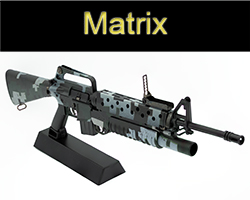M16A1
History of the M16A1
Research conducted after the Korean war found that most hits on target were lucky shots withing 300 meters. This contradicted the up until now held obsession with long range aimed fire that the army had been aiming for. This study led to Project SALVO which was conducted from 1952 until 1957 to develop a new small bore military rifle capable of firing multiple high velocity rounds. From the late 1950s to the early 1960s there was a lot of experimentation with ammo type and caliber as well as rifle design.
In 1957 the Army requested the development of a lightweight select fire rifle that shoots a 0.22 caliber bullet that can penetrate a standard steel helmet from 500 yards from one of their partners, Armalite. A man name Eugene Stoner took the reigns on the rifle design basing the design off his early AR-10 rifle. At the same time experts at Sierra Bullets and Remington began developing the cartridge. The following year, the army was testing the new rifle dubbed the AR-15, while its performance was favorable and some of the testers even claimed it was the best lightweight rifle they tested, it rejected it for the recently adopted M14 which was essentially an improved M1 Garand with a twenty round magazine and automatic fire capability.
In 1959 the parent company for Armalite sold the rights and manufacturing documentation to Colt. Colt then used their relations and proven track record to begin an aggressive marketing campaign promoting their new rifle. In 1962 the US government bought 1000 AR-15s and sent them to The US Army Special Forces in South Vietnam for field trials. These trials generated glowing reports about their effectiveness in combat and the stopping power of the 5.56 cartridge.
Due to production troubles with the M14, in 1963 the Government contracted Colt with and order for 19,000 rifles to go to the US Air Force, designated M16 which was an AR-15 with specific marking on it, and a second order for 85,000 rifles for the US Army designated XM16E1. This model had a new mechanism added to it called the forward assist, that would allow the operator to manually push the bolt forward in the event of a jam. These purchases were initially just to supplement the shortage of M14s.
With the US Military's involvement in Vietnam the government ordered 840,000 M16 rifles in 1966 to supply its troops. Following this purchase in 1967, the US Army officially adopted the XM16E1 as the standard service rifle and redesignated it as the M16A1. The following years there were many reports of the firearm jamming up at critical moments resulting in lose of troops.
Part of the problem was due to the US Army's decision to use a cheaper gun powder in the cartridge that led to fast carbon build up in the direct impingement system. This powder also burned with a different pressure curve resulting in higher stress on the operating parts, combined with Colts claim of the gun being self-cleaning so cleaning supplies were not procured for the M16s. Also, in a cost saving decision by the US Army they opted to forego the chromium plating of the barrel bore and bolt group increasing the rifles susceptibility to corrosion.
They changed the gunpowder and added the chromium plating and issued cleaning kits to the troops, by 1970 the rifles were manufactured with a compartment in the buttstock for the cleaning kits and traded in the twenty round magazines for thirty round ones to compete with the soviet Aks. By this point in time the rifle was considered mature, but small refinements to the components of the firearm continue to this day.
GoatGuns Models






